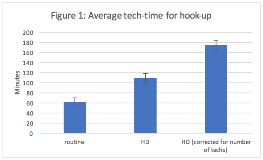A Quantification of the Cost of HD EEG in Technologist-Minutes
Abstract number :
3.130
Submission category :
3. Neurophysiology / 3C. Other Clinical EEG
Year :
2018
Submission ID :
502618
Source :
www.aesnet.org
Presentation date :
12/3/2018 1:55:12 PM
Published date :
Nov 5, 2018, 18:00 PM
Authors :
Janie Conway-Kinstler, Mayo Clinic; Jeffrey W. Britton, Mayo Clinic; Brian N. Lundstrom, Mayo Clinic; Lily Wong-Kisiel, Mayo Clinic; Elson So, Mayo Clinic; Gregory A. Worrell; Benjamin H. Brinkmann; and Kenney-Jung Daniel, Mayo Clinic
Rationale: EEG using more electrodes than the standard 10-20 montage, also known as high-density EEG (HD EEG) shows promise for better localizing epileptogenic foci during a presurgical workup, particularly when used as a component of techniques such as electrical source imaging. However, the cost of prolonged monitoring with HD EEG has not been established. This is particularly problematic as prolonged monitoring is often not practical for EEG caps, and therefore requires frequent maintenance by EEG technologists. This study attempts to quantify the costs of HD EEG during prolonged monitoring. Methods: 33 consecutive patients undergoing prolonged EEG monitoring (standard 10-20 montage with 32 electrodes, attached with collodion) and 39 consecutive patients receiving prolonged HD EEG monitoring (10-10 montage with 76 electrodes, attached with collodion) were compared with respect to the amount of time required for EEG hookup, time on monitoring, time required for maintenance and number of technologists involved in EEG hookup and maintenance. Results: Patients with high-density EEG were on EEG monitoring for an average of 4.46 days, longer than the average for standard-montage EEG (3.33 days; p = 0.003). The average time for connecting patients to HD EEG was significantly longer than the time spent hooking up patients for standard montage EEG (108.6 minutes for HD EEG versus 61.9 minutes for the standard montage). HD EEG hookup often required more than one technologist, using an average of 1.6 technologists while standard montage required only one technologist for hookup. When corrected for the number of techs involved, HD EEG required 173.76 technologist-minutes versus 61.9 technologist-minutes for the standard montage (Figure 1). With respect to maintenance, routine EEG requires an average of 6.5 minutes/day, versus 21.3 minutes/day for the HD EEG (Figure 2). In both cases, there was a correlation between the average amount of time required for maintenance and the amount of time that a patient was monitored, with correlation constants of 0.79 for the standard array and 0.80 for HD EEG.Assuming an hourly pay of $30.00/hour, hookup and 4 days of monitoring with HD EEG costs $129.48 in EEG tech time, versus $43.95 for the standard EEG array. This does not include overtime, time spent reading or editing the study or costs for data storage, nor does it include any equipment or hospital costs. Conclusions: While HD EEG can provide substantial patient benefits, particularly with respect to localization of epileptogenic foci during the evaluation of surgical epilepsy, costs in tech-minutes are approximately three times higher for prolonged HD EEG monitoring. These additional costs must be borne in mind for any sustainable practice employing HD EEG routinely, and staffing decisions must be made accordingly. For either type of study, costs in tech-minutes increase linearly with the amount of time that a patient is being monitored. These results support the need for a separate CPT procedural code for HD EEG given the significant increment in technologist effort required for these studies. Funding: None

.tmb-.png?Culture=en&sfvrsn=76f8d676_0)